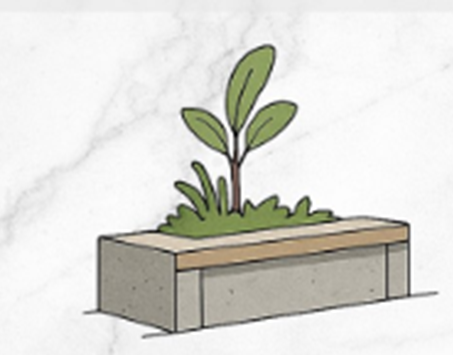Types of Planter Boxes for Sustainable Landscaping & Modern Architecture
Planter boxes are more than just decorative features – they are eco-friendly, functional, and profitable investments in modern landscaping and urban architecture. From managing stormwater to creating vertical green facades, the right planter system can boost property value, sustainability ratings, and curb appeal.
Types of planter boxes:
1. Flushed
2. Raised
3. Clustered
4. Façade-Integrated
1. Flushed Planter Boxes – Stormwater Management & Sidewalk Greenery
Flushed planter boxes are integrated into sidewalks, creating a seamless, continuous landscape.
- Built with strong concrete slabs to support soil depth & load requirements.
- Installed with drainage cells that improve water infiltration, reduce excess weight, and store water for passive irrigation.
- Positioned slightly lower than sidewalk level to direct storm water runoff into the planter.
Best for: Urban streetscapes, sidewalks, and public plazas.
Benefits: Flood reduction, urban cooling, improved walkability.
2. Raised Planter Boxes – Courtyard Landscaping & Public Seating
Raised planter boxes are elevated above ground and can double as seating ledges in public spaces.
- Uses Ellipse Tank Module systems, offering a higher water storage capacity than gravel-based systems.
- Depth can be adjusted for flowers, shrubs, or even small trees.
- Commonly placed in courtyards, plazas, bus stops, and riverside landscapes.
Seater's Integrated with Planters along street side walks, Bus stops, etc.,
3. Clustered Planter Boxes – Aesthetic Rhythm & Visual Impact
Clustered planters are grouped together to create visual rhythm and symmetry.
- Odd-number clusters (3, 5, 7) create interest and highlight each plant.
- Varied heights of planters add depth and enhance design appeal.
- Often used in residential terraces, commercial plazas, and corporate campuses.
4. Façade-Integrated Planter Boxes – Vertical Green Walls
Façade planters act as a green skin for buildings, blending aesthetics with performance.
- Reduce heat gain and improve indoor comfort.
- Provide greenery pockets along corridors, balconies, and exterior walls.
- Contribute to green building certifications such as LEED, GRIHA, or WELL.
Why Planter Boxes Are Essential for Sustainable Cities
- Reduce storm water runoff
- Mitigate urban heat island effect
- Support urban biodiversity
- Enhance property value & marketability
- Earn green building certification credits
Final Thoughts
Whether you are an architect, developer, or homeowner, choosing the right planter box type can transform spaces into sustainable, functional, and aesthetically pleasing environments. From flushed sidewalk planters to high-rise façade-integrated green walls, planter boxes are shaping the future of urban landscaping.
Ready to integrate planter boxes into your project? Explore modern planter solutions for sustainable architecture today.






























.jpg)
.jpg)
.jpg)
.jpg)
.jpg)
.jpg)
.jpg)
.jpg)
.jpg)
0 Comments